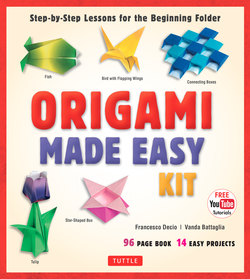Читать книгу Origami Made Easy Ebook - Vanda Battaglia - Страница 7
На сайте Литреса книга снята с продажи.
ОглавлениеHOW TO FOLD PAPER
One aspect of origami that is often taken for granted is how to fold paper. Paper is much more “sensitive” than, say, a voice recording. Any trace of sound can be erased from recorded material, but this is impossible with paper. A fold once executed can never be undone. It is indelible. This characteristic of paper is sometimes cherished and deliberately exploited in order to create a certain type of origami.
It is necessary to treat each fold as important even before executing it. Generally, the layer to be folded is lifted with one hand, which draws its edge to a central point while the other hand holds the sheet firmly in place. The edge is thus positioned so that it aligns with the baseline. At this point, nothing is folded and the sheet is still softly rounded at the place of the fold. The alignment needs to be carefully checked at this stage to ensure that everything is in place. Only then should the paper be delicately flattened out, with a light movement towards the fold’s corner. The corner must then be passed over again, from the center towards the outside, first along one edge, and then the other. Once this has been done, finish the fold by passing over its edge one more time with the back of a fingernail to make it crisp and well-defined. These moves will soon become automatic. This is why it is essential to master the foundations from the start.
Another thing that is often taken for granted, especially by beginners, is the importance of the surface on which the folds are made. It must be smooth and hard. A kitchen table without a tablecloth is ideal. In Japanese temples, it is customary to fold the paper in the air, to avoid contact with any surface that might “contaminate” its purity. This can only be done at a later stage, after considerable practice.
It is important to prepare the fold before executing it. One hand grabs the bottom edge to bring it up to meet the top edge, while the other holds the sheet firmly down on the working surface.
After the two edges are aligned, start flattening the paper, beginning at the point where it is rounded.
After smoothing the paper vertically (as shown in fig. 2), smooth the paper horizontally.
To press the fold permanently and neatly, pass over it with the back of a fingernail, usually the thumbnail (or a bone folder, or the bowl of a spoon, if you prefer).
The completed fold is shown below. It illustrates two important points that can later be used to advantage. The first is color. Classic origami paper is two-colored, that is, white on one side and dyed on the other. Color is extremely useful in diagrams and models for checking whether a sequence of folds has been properly followed.
The second point concerns layers. If a sheet of paper is folded in half, it results in two superimposed layers, color on one side, white on the other. This is obvious in a simple fold. Color is much more significant for more complex models. It enables you to check how carefully you have executed the model. You can check whether a certain layer is colored, as in the illustration, or whether there are more layers in a given area as required by the design, or whether the angle of a corner is more or less as it should be according to the instructions. This is the purpose of a drawing with “borderless” layers.
Generally speaking, unless otherwise indicated, the fold divides the model or one of its parts in half or its multiples (¼, ¹⁄8, ¹⁄16, and so on).
It is essential to learn how to recognize and interpret the details that appear in each image, whether this is a diagram or a completed model.
